How to make a Hydrogen Booster for your vehicle
DIY Vehicle Hydrogen Booster
How to make a Hydrogen Booster for your vehicle
This site will guide you through the steps necessary to make your own Hydrogen Booster for your car. This is also known under various other names such as H2O Booster, Water4Gas, Browns Gas Booster, and many others. There are many resources out there which show one how to build a water booster for a gas engine vehicle, but we have decided to take all the best points from them all and combine them here in one single, comprehensive page.
We have been experimenting with Browns Gas in autos for many years now. It is time for us to show the world what we have learned. We have tried many different ideas before settling on the best one for our own vehicles. The system shown here is the most stable, reliable and safe found so far. It is also one of the most efficient systems we have tested.
In this section we will cover how to make the DIY hydrogen booster chamber itself with its fittings, terminals and plates. In later sections we will cover the electrical connections, installation of a flash / backfire suppressor, connecting to the carburetor or fuel injection system and finally, the modifications - if any - needed to your car itself.

We use 4 inch PVC pipe from Home Depot for the main water chamber due to its 1/4 inch thick walls and heat and chemical resistance. And, since we use 1/4 inch end caps and fittings outside the pipe, the total wall thickness is 1/2 inch. This thing is almost bullet proof. Free Hydrogen Booster Plans :
Here is a list of things you will need:
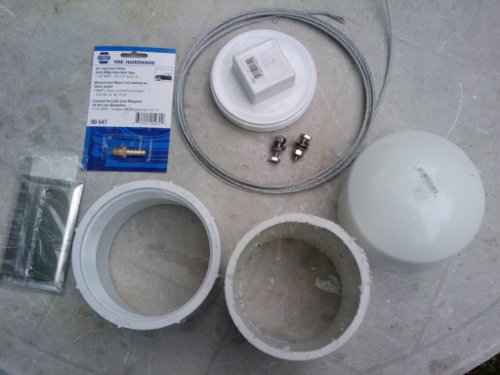
- About a foot of 4" PVC pipe.
- 4" PVC Fitting, with inside threads
- 4" PVC End Cap, round
- 4" PVC End Cap, threaded
- 1/4 inch brass hose connector
- PVC Cement
- 2x 1/4 inch Stainless Steel Screws
- 4x 1/4 inch Stainless Steel Washers
- 4x 1/4 inch Stainless Steel Nuts
- 7x Stainless Steel Wall Cover Plates
- Stainless Steel Banding Material or Wire
- 2x Nylon Screws 10-24 by 1.5 inches long
- 4x Nylon Nuts 10-24
- 12x Rubber Washers 1/8 inch thick
- 3 Feet 1/4 inch Auto Vacuum Line Tubing
You will need a few tools ready for the job. A tap and die set is necessary to thread the screws and brass fitting into the threaded cap. This is very important to make an air tight seal in the chamber. A drill press is handy, but not required, to make straight holes in your work. Also a few drill bits and some wrenches. Sandpaper or a dremel tool is needed to rough up the stainless steel cover plates. And, last, a hacksaw to cut the PVC pipe.
Please carefully follow the instructions below.
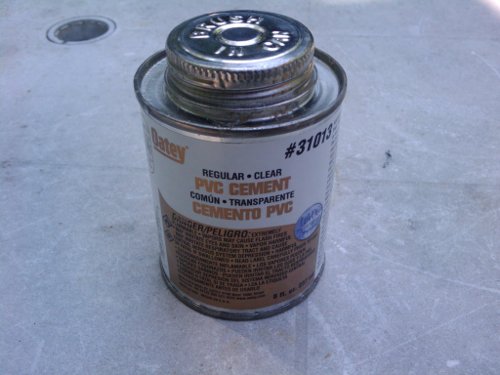
PVC cement is used to glue all the parts together for your H2O Booster
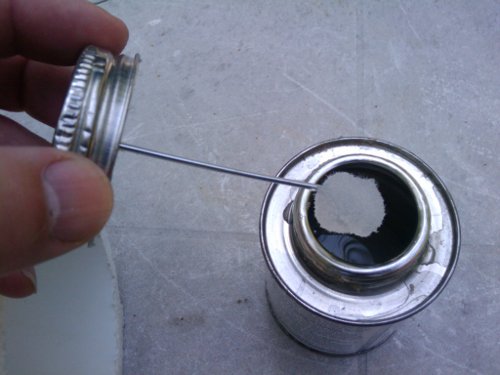
Start to coat parts with PVC cement
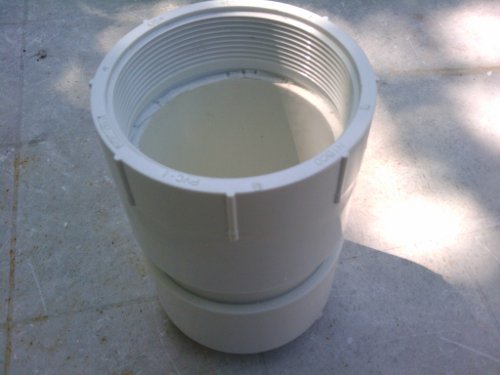
The Hydrogen Booster tank is cemented together

See this complete H2O booster for help
In the photos above, you can see the PVC cement needed to securely glue the PVC pipe and connectors together. This gives us an air tight seal, up to 180psi. Read the instructions on the cement for details. First, use a hacksaw and cut off about 4-5 inches of PVC pipe. Clean the rough edges off. Next, wash all parts thoroughly. Then coat one end of your PVC pipe with the cement. Coat the inside of the rounded bottom cap with cement. Then apply a second coat of cement to the end of your pipe. Now press them together, twisting a bit to push the pipe all the way into the end cap. Hold it in place for at least 30 seconds. Now you can take the threaded female adapter and cement it to the other end of the pipe. At this point, it should look like the third picture above. You can see a complete water gas system in the last picture above for reference.

Stainless Steel Plates for the HHO Booster
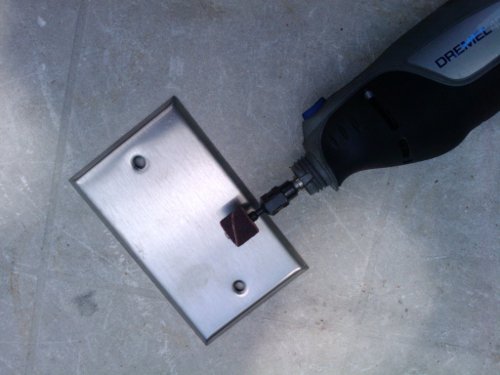
Sand a crosshatch pattern in the SS plates
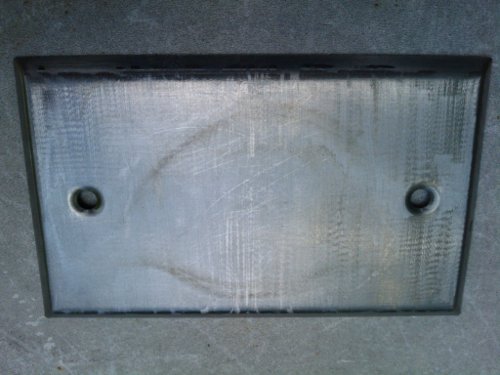
The SS plates are ready to install in booster
Get some sandpaper or a dremel tool and a sanding wheel. Sand a crosshatch pattern in both sides of your stainless steel (SS) wall cover plates. Sand first one direction, then turn the plates 90 degrees and sand again, creating a crosshatch pattern. This will increase the overall plate surface area and also help the hydrogen and oxygen gas bubbles to escape off the plates easier. See the photos above.
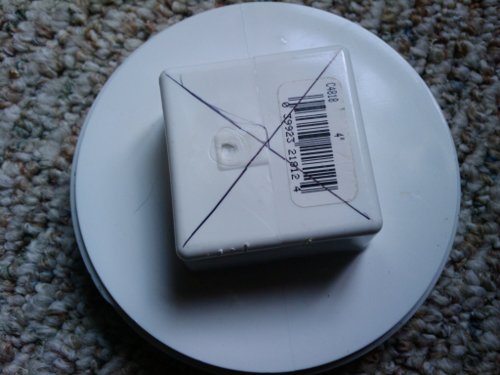
Mark the center of the Hydrogen Booster end cap
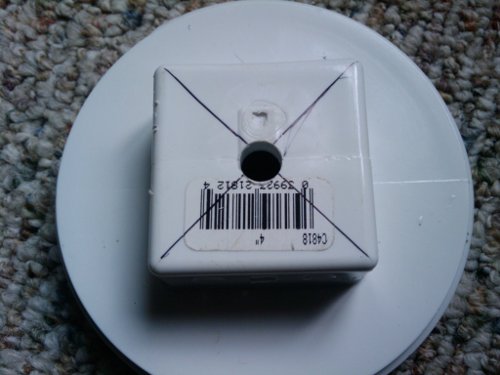
Hole is drilled into water splitter cap
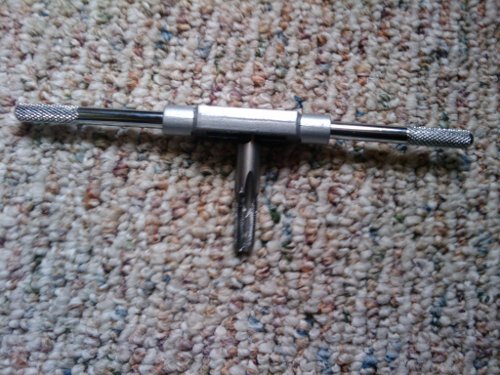
Tool used to thread hole.
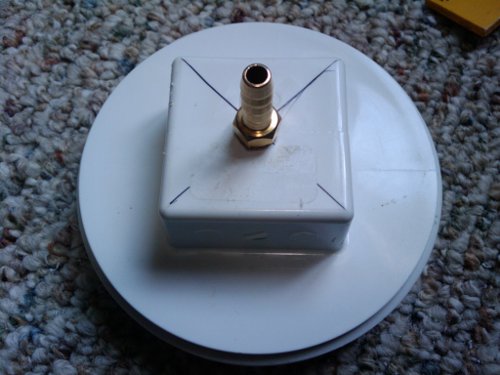
Make sure brass fitting screws in properly
Use a ruler to mark off the exact center of your water booster cap. Then drill out the hole with a bit just smaller than the threads on your brass fitting. We want to thread the hole later. We use a 1/8 inch MNPT thread with 1/4 inch hose fitting, so we used a 23/64 inch drill bit. Using a drill press for this part is better to get a perfect straight hole. If you go off center, the threads may not be tight enough later. We want a perfect air tight fit. Hydrogen is a very fine gas and can seep through the smallest holes.
The next step is the thread the hole with a tap and die set. To fit our brass fitting, we use a 18 inch MNPT pipe tap. After you are finished, try the brass fitting in your H2O booster cap for tightness.
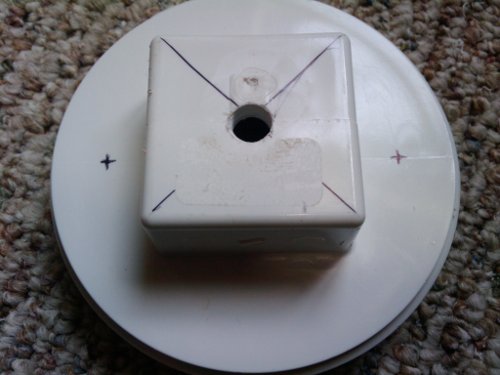
Mark the center for your terminal screws
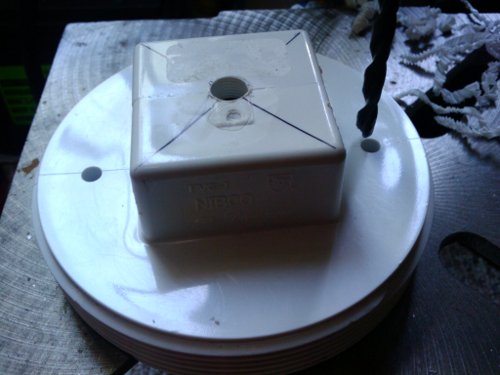
Drill the terminal screw holes in your water booster cap
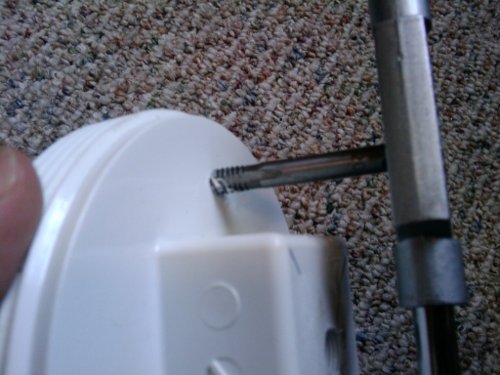
Thread the terminal screw holes.
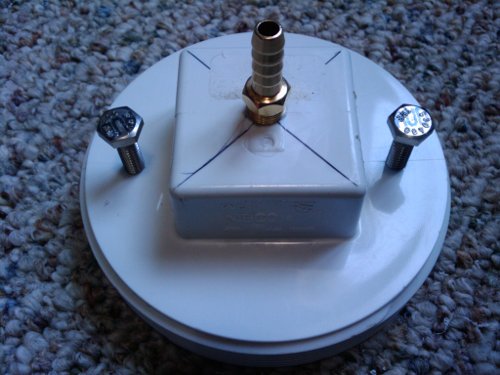
Try all threads for a good fit
Mark the hole positions for the terminal screws. We use a half inch in from the edge of the cap. There is a casting mark, that conveniently shows the exact center of the cap. Mark a half inch in on that line. Drill the holes using a 7/32 inch drill bit. Again, the hole should be just smaller than the threads of the screw. Next, you can use the tap and die set and thread the holes with a 1/4NC20 bit. Try the new threads for fit. Just thread them in part way to see that they work well.
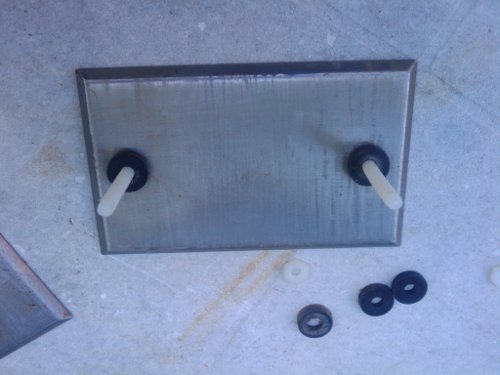
Start assembling water gas plates

Complete water4gas plate assembly
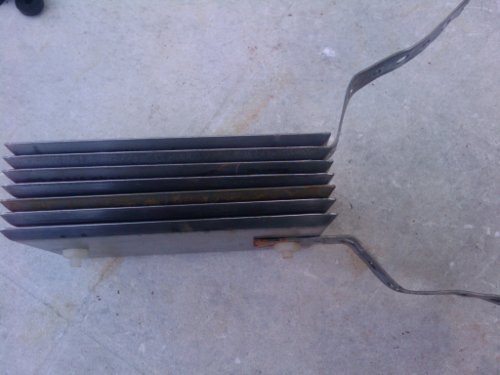
Attach SS conductors to your plate assembly.

Screw conductors to your terminals
Get your stainless steel plates, rubber washers and nylon screws. Put a nylon screw through each hole in one of the SS plates. Next feed a washer onto each screw. See first photo above. Then feed on another plate, then more washers and so on until you have a stack of seven plates. See second photo above. Do not put on the nuts yet.
Now cut some SS banding material or Stainless Steel wire for the conductors. You will want the plates to hang down inside your water chamber a couple inches. Measure to fit. Take one of the screws carefully out of the stack of plates you just made. It should slide out easily without the whole thing falling apart. Slip one of the conductors onto the screw and feed it back through the plates. Now attach the second conductor to the other side. Now you can thread on the nuts to hold it all together. Do not tighten it too much or you will squash the rubber washers. Use a second nylon nut on each screw to lock it all together.
Bend the other end of your banding material/wire to fit up into the lid of your water booster chamber. Put a washer on one of your stainless steel screws and coat it liberally with PVC cement. Now feed it into the threaded hole of the lid, from the bottom, outward and through the conductor. Do the same with the other side. Put a little bit of cement on the outside of the cap, around the screws that are sticking up. Use another washer on each screw and tighten the screws securely with a wrench. Wait a second and tighten a bit more. The screw will dig into the plastic a little due to the PVC cement melting the plastic. This will make a sure, air tight seal around the threads of the screw. (Above photos).
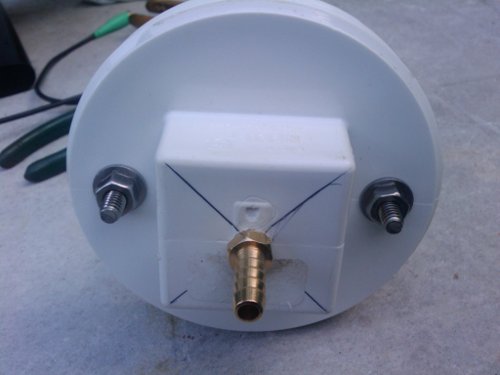
Top view of completed hydrogen booster assembly
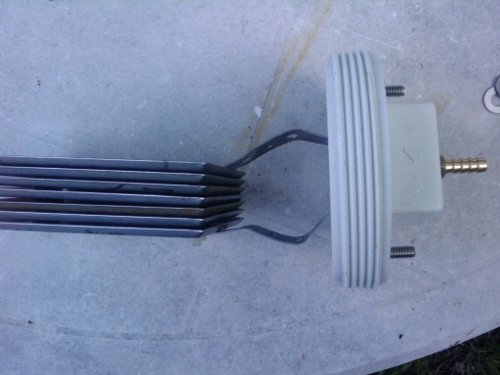
The completed HHO Booster plate assembly
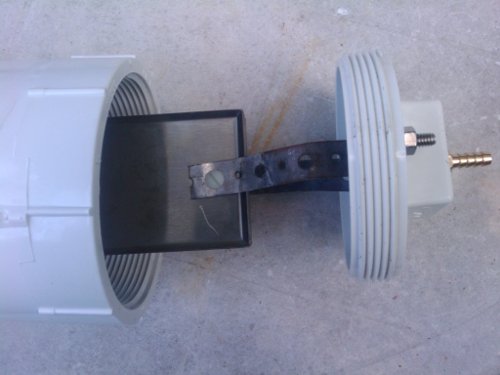
Screw the plate assembly into HHO tank.
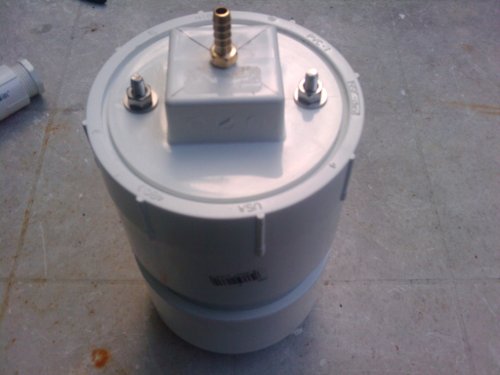
The complete Hydroxy Gas Booster
Coat the threads of the brass fitting with PVC cement and screw it into the water booster cap. Tighten it a bit. Now, coat both the inside and outside of the cap around the brass fitting with some cement. Tighten the fitting down all the way. It should bite into the plastic a little. This will create a good seal around the fitting. See first picture above.
See the second picture above for a view of your completed plate and lid assembly for your new water booster. Now take the case of your water chamber and screw the lid into the threaded portion of the water chamber. Later we will fill this with water and caustic soda solution. The last photo above shows the completed hydrogen gas booster assembly.
Next see how to make a backfire supressor.
Feel free to ask any questions or get help with your project on our
Final Notes:
Hydrogen gas is highly explosive. Use extreme caution working with this system and wear eye and ear protection any time you work near one. Also use caution working with electricity. The hydrogen gas boosters use between ten and thirty amps of power. This is enough to quickly kill a person.
Disclaimer: The ideas presented here are for informational purposes only. Experiment at your own risk. We assume no responsibility whatsoever.
About the Author
| Troy Reid |




